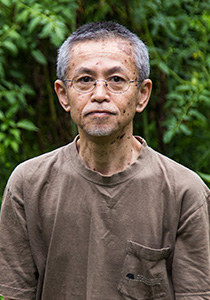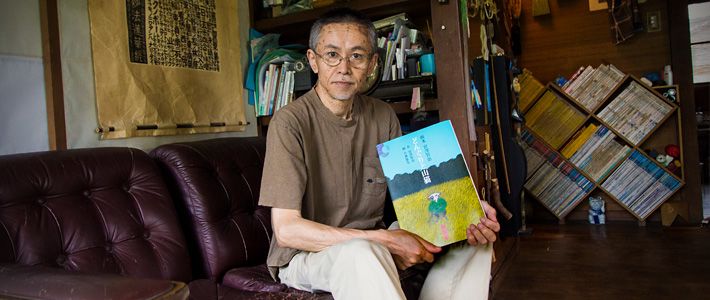
New Perspectives on Miyazawa Kenji
Miyazawa Kenji and the Art of the Picture Book: The Work of Kobayashi Toshiya
Culture- English
- 日本語
- 简体字
- 繁體字
- Français
- Español
- العربية
- Русский
The Yamaneko Atelier lies nestled in a secluded wood along the banks of the Tamagawa river in Ōme, a municipality situated near the mountainous northwestern limits of metropolitan Tokyo. This rustic retreat is where illustrator Kobayashi Toshiya has pursued his life’s work, a series of extraordinary picture books inspired by the stories of Miyazawa Kenji. Since 1979, he has published 16 volumes in the series, from Donguri to yamaneko (“Acorns and Wildcat”) in 1979 to his latest, Zashiki bokko no hanashi (Sprite Stories) in 2016, along with five other books relating to Miyazawa Kenji.
Open any of the books in this series, and you are instantly transported to the literary world of Miyazawa Kenji courtesy of Kobayashi’s compelling illustrations. His unique application of the scratchboard technique and spot-color printing method, combined with the use of textured paper, creates the effect of an original woodblock print. In addition to creating the artwork and lettering for the text, Kobayashi oversees each stage of the design and publication process, down to the choice of paper. The result is a rich, multilayered work of art that rewards leisurely and repeated examination.
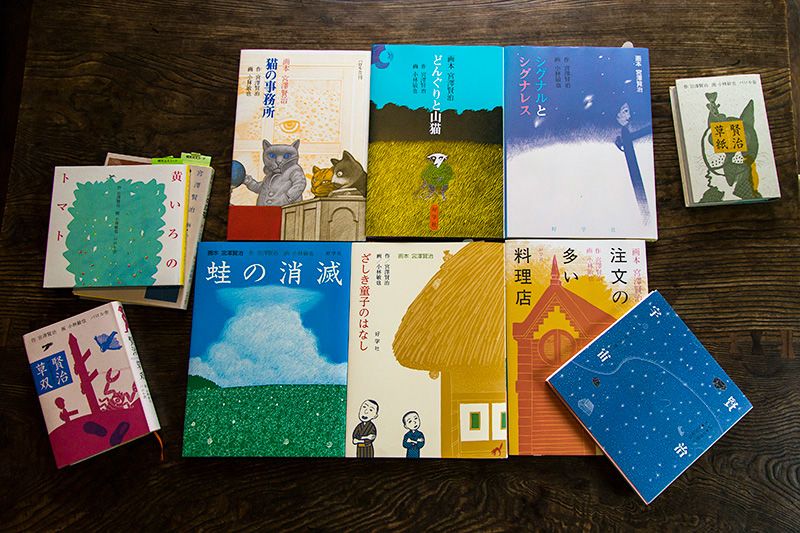 A selection of Kobayashi's picture books based on the work of Miyazawa Kenji.
A selection of Kobayashi's picture books based on the work of Miyazawa Kenji.
Picture Books for All Ages
Kobayashi came to Miyazawa Kenji’s work relatively late in life. As a child growing up in Yaizu, Shizuoka Prefecture, he had little contact with such literature. Like so many boys his age, Kobayashi was under the spell of such serialized comics as Tezuka Osamu’s Tetsuwan Atomu (Astro Boy), and he spent much of his free time drawing manga himself.
In 1966, Kobayashi entered the crafts department of Tokyo University of the Arts. He was in his late teens when the Tokyo Olympics, a milestone in Japan’s miraculous postwar resurgence, was held in 1964. The memorable Olympic posters of Kamekura Yūsaku helped fuel a boom in graphic design, and the world of advertising beckoned those with creative inclinations. Against this backdrop, Kobayashi decided to pursue a career as a graphic designer.
Another important influence during this time was Kobayashi’s encounter with The Little Prince, the famed novella written and illustrated by the French poet and aviator Antoine de Saint-Exupery (1900–1944). Ostensibly a picture book for children, the work had been translated into dozens of languages, including Japanese. “Adults all over the world were reading it, and it had become a bestseller in Europe and America,” recalls Kobayashi. “It’s a book that children love, but it also holds a deep message for adults. I remember thinking, ‘That’s the kind of book I’d like to create some day.’”
Kobayashi graduated in 1970 and started work as a graphic designer at a packaging company. In his spare time, he frequented the huge Maruzen bookstore in Nihonbashi, where he found himself drawn to the international picture book section. “These were books that an adult could appreciate,” he says. “There was still nothing like that in Japan at the time, and I was intrigued by this new world of possibilities.” Henri’s Walk to Paris (1962), illustrated by the American graphic designer Saul Bass, was one of his favorites. Bass, who is better known for his film title sequences, posters, and corporate logos, limited his depiction of the story’s characters to their feet. Kobayashi was struck both by the creativity of Bass’s approach and by the high quality of printing and paper. “I realized how much fun it would be to step into that kind of world.”
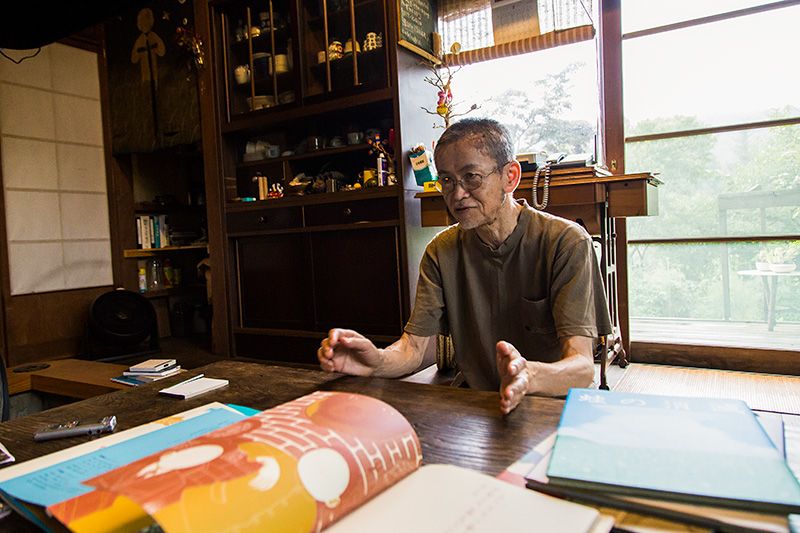 In addition to providing the artwork for the Kenji series, Kobayashi carefully oversees the design and publication of his books, including paper selection, printing, and binding.
In addition to providing the artwork for the Kenji series, Kobayashi carefully oversees the design and publication of his books, including paper selection, printing, and binding.
An Original Work of Art
It was not until a few years later, after he had quit his job to work freelance, that Kobayashi turned to Miyazawa Kenji for inspiration. He had read through Kenji’s work during his college years, but with the appearance of The Complete Works of Miyazawa Kenji beginning in the mid-1970s, Kobayashi gained a renewed appreciation of the size and caliber of his oeuvre.
“Some people say that Kenji’s works are difficult to read, but I wasn’t put off by them; his writing has a distinct rhythm to it. He covers a wide range of themes, and he does so in a way that resonates with adults as well as children. For example, in Tsuchigami to kitsune [“The Earthgod and the Fox”], the deity is competing with the fox for a tree’s affections, and he ends up trampling the fox to death. It’s high drama even for an adult reader.”
Kobayashi had already seen a few picture books based on Kenji’s stories, but he found them less than inspiring. “I thought I could do better,” he says.
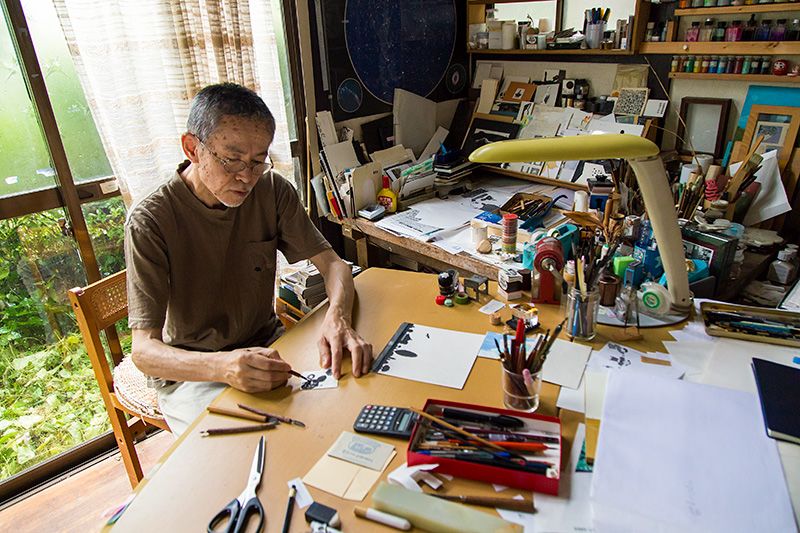 Kobayashi at work in his Yamaneko Atelier.
Kobayashi at work in his Yamaneko Atelier.
Kobayashi started out by imagining and rendering a few scenes from such stories as “The Earthgod and the Fox,” “Acorns and Wildcat,” and Sero hiki no Gōshu (“Gorsch the Cellist”), and sending the resulting illustrations to a number of publishers. At length one of them expressed interest, and Kobayashi embarked on what was to become his life’s work.
For the first book in the series, the story “Acorns and Wildcat,” Kobayashi adopted the scratchboard method, a monochrome technique in which the artist uses a stylus to scratch the black coating off a special board. Later it occurred to him that he could add variety and depth in the printing process by creating more than one image of the same scene and printing them one over the other using different colors of ink, a method reminiscent of color woodblock printing. In subsequent works he relied more heavily on this technique, preparing two or more originals per illustration. The printing technique he adopted, called spot-color printing, applies custom-mixed ink instead of separating a photographic image into four color values and reconstructing it with tiny dots.
▼Further reading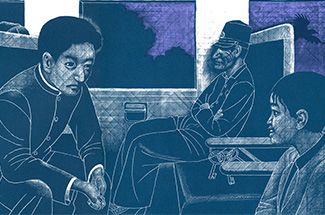 Illustrating Miyazawa Kenji (Photo Gallery) Illustrating Miyazawa Kenji (Photo Gallery) |
“With most picture books, you start with an original polychrome image, and the [four-color] printing process aims to reproduce those colors as closely as possible,” he explains. “But I have no original color artwork to reproduce, just black-and-white. So, in terms of color illustrations, the printed books are the originals.” In fact, from Kobayashi’s viewpoint, the appeal of this technique lies largely in the thought that he is offering each reader the work as intended, rather than an inferior copy.
Kobayashi’s most recent work, Zashiki bokko no hanashi (Sprite Stories), comes after a 16-year hiatus following the bankruptcy of his former publisher. During this period, Miyazawa Kenji’s native Iwate Prefecture experienced the disaster of the 2011 Tohoku earthquake and tsunami. As Kobayashi notes, Kenji was born in the year of the 1896 Sanriku earthquake, which triggered a massive tsunami that likewise devastated the coast of Iwate, and he died in 1933, when a similar earthquake and tsunami hit the region. The inspiration for Kobayashi’s latest picture book is a story rooted in the folklore of the region, a recitation of four tales about the childlike household ghosts known in Iwate as zashiki bokko. Kobayashi’s picture-book version is rich in sympathetically rendered depictions of the region’s children and scenery, not to mention the sprites themselves.
Layers of Meaning
Kobayashi claims to have little interest in Miyazawa Kenji beyond the potential of his stories to provide “screenplays” for Kobayashi’s picture-book project.
“The world of Kenji is broad and deep,” he says. “He had a wide range of interests, spanning religion and science as well, and many people are fascinated and inspired by the way he lived his life. But I’ve always focused squarely on the task of turning his stories into picture books. I don’t have the capacity for anything beyond that.”
Even so, Kobayashi has discovered new layers of meaning in Kenji’s literature over the years, and those layers have found their way into his picture books. “Gradually I began to inject some of my own feelings and thoughts about the world into my books.”
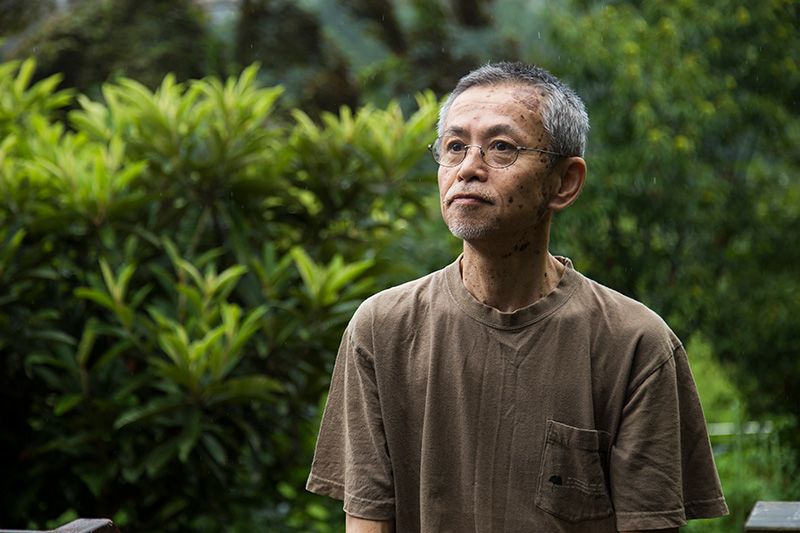 Kobayashi’s interpretation of Kenji’s work has evolved over the years.
Kobayashi’s interpretation of Kenji’s work has evolved over the years.
For example, Kobayashi’s selection and treatment of Kaeru no shōmetsu (Disappearance of the Frogs; 2000) reflected his state of mind in the aftermath of the 1999 nuclear accident in Tōkaimura, Ibaraki Prefecture. In this cynical story, three greedy frogs end up dying in a hole as a result of their obsession with acquiring rubber boots. Kenji later reworked the story as Kaeru no gomu kutsu (The Frogs and the Rubber Boots), which ends happily. But Kobayashi chose the first version as a parable of humanity’s self-destructive greed, as embodied in nuclear power. In fact, he deliberately incorporated the image of a nuclear power plant and high-voltage power lines into his scenery.
“I was born in Yaizu, the home port of the Daigo Fukuryū Maru,” notes Kobayashi. “The Bikini Atoll incident [in which the crew of that fishing boat was poisoned by fallout] took place when I was in elementary school, and I’ve been conscious of the dangers of radiation and nuclear energy ever since.”
That said, Kobayashi’s picture books are not heavily message-driven. “I want my books to open people’s eyes to all the wonderful stories Kenji wrote,” he says. “That’s the main thing. The second thing is to get people thinking about how those stories might apply to their own lives.”
(Originally published in Japanese on September 20, 2016.)